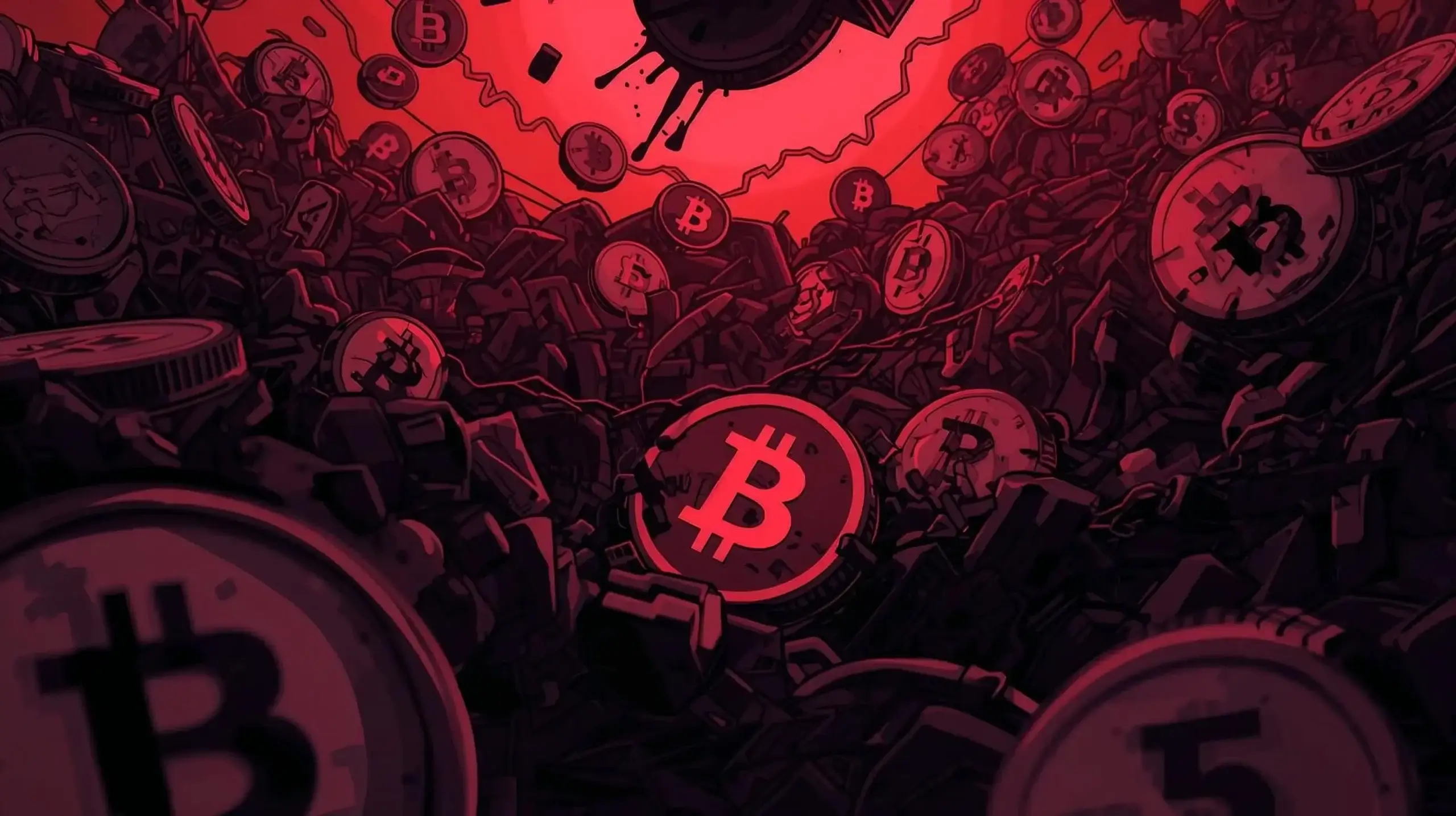Small Cap Tokens Buckle as Crypto Market Turmoil Deepens

The digital asset market is caught in an intense and prolonged downturn, and the pressure has become especially severe for smaller, more speculative cryptocurrencies.
While sharp swings are nothing new for this asset class, the current wave of selling has pushed some of the weakest corners of the sector to levels not seen in several years, and there is little indication that sentiment will improve soon.
At the center of the current decline is the MarketVector Digital Assets 100 Small Cap Index, an index designed to track the performance of the 50 least capitalized tokens within a broader basket of 100 cryptocurrencies.
Over the weekend, that benchmark slipped to its lowest reading since late 2020 before recovering some ground. Even with that modest bounce, its trajectory tells a clear story.
Investors have been abandoning the riskiest tokens, and the retreat has been both abrupt and widespread.
Bitcoin’s Slide Sets the Tone
Bitcoin, the dominant cryptocurrency and the asset that often sets the mood for the entire market, has been unable to escape the selloff.
After climbing roughly 30 percent earlier in the year and touching a record in October, the original digital currency has given up that progress entirely.
Its reversal has dealt a psychological blow to traders who had hoped that institutional adoption and regulatory advances would provide a more stable floor for prices.
Where Bitcoin goes, the rest of the market often follows. Yet during this downturn, altcoins have been hit far harder than their established counterparts.
Their underperformance has been building since the beginning of 2024 and has now intensified to the point where long-standing assumptions about market cycles are being called into question.
Altcoins have historically thrived during periods of bullish market conditions. In several previous runs, small-cap tokens have vastly outperformed major assets, such as Bitcoin and Ether.
Traders chased highly volatile projects in pursuit of quick gains, and many succeeded. However, the tone of the current cycle has been very different.
Several analysts argue that the introduction of spot Bitcoin and Ether exchange-traded products in the United States has channeled attention, and more importantly, capital, toward the largest and most recognizable cryptocurrencies. Institutions that once diversified their investments are now favoring the major players, leaving less liquidity for smaller projects.
A New Reality for Retail Traders
Pratik Kala, portfolio manager at an Australia-based hedge fund, Apollo Crypto, believes retail participants have become more selective since the chaotic cycles of prior years.
According to him, many individual traders have learned the hard way that enthusiasm alone does not guarantee success in this fast-moving environment.
He notes that earlier bull markets lifted nearly every token simply because money poured in from all directions. By contrast, he believes the present market rewards projects that demonstrate durability, meaningful technology, or robust communities.
In his words, a rising tide does not elevate every vessel equally anymore. Only those considered higher quality receive meaningful support.
This shift in behavior has undermined the hope of many issuers preparing to launch crypto-based exchange-traded funds. For years, companies have anticipated a flood of new products tied to smaller tokens.
By mid-October, approximately 130 applications for such ETFs were pending review by the United States Securities and Exchange Commission.
Expectations ran high that approval of Bitcoin and Ether funds would eventually pave the way for similar products tied to a broader range of assets.
However, with altcoins sinking and investor interest fading, these plans now appear fragile. Issuers need strong demand to justify launching highly targeted funds.
Without meaningful inflows, such products struggle to gain traction. Some examples already show how weak that demand can be.
A recently introduced ETF tied to Dogecoin debuted in September under the ticker DOJE. Although Dogecoin has long enjoyed a loyal following and extensive name recognition, the ETF has not attracted any inflows since mid-October.
Meanwhile, the token itself has fallen about 13 percent over the past month, underscoring how quickly sentiment has cooled.
Small Caps Struggle to Keep Pace
The contrasting fortunes of major and minor cryptocurrencies have become increasingly stark over the past five years. While the small-cap index is down by nearly 8% over that period, its large-cap equivalent has soared by almost 380%.
The discrepancy highlights the dramatic shift in investor preferences. Large-cap assets have become regarded as the safer segment of a risky market, and traders appear increasingly unwilling to venture far from that perceived safety net.
Several factors contribute to this divide. Liquidity plays a key role. Larger tokens offer deeper markets, making it easier for buyers and sellers to transact without drastic price movements.
Institutions, which now represent a larger share of crypto trading volume than they once did, tend to avoid assets that exhibit thin liquidity or unpredictable trading behavior. These preferences leave small-cap tokens exposed when volatility increases.
Regulatory uncertainty also weighs heavily on lower-tier assets. The SEC has taken an aggressive stance on determining which digital assets may constitute securities.
Many small projects lack the resources to mount significant legal defenses or pursue costly compliance efforts. As a result, traders may avoid them out of caution, reducing both visibility and liquidity.
Aftermath of the October Crash
The downturn has been exacerbated by the dramatic market collapse that occurred on October 10. That single episode triggered approximately nineteen billion dollars in liquidations across futures and leveraged positions.
It also erased more than one trillion dollars in value from the combined pool of digital assets. The shock reverberated throughout the market, and recovery has been slow.
Since that event, risk appetite has shriveled. Market makers, who supply liquidity and maintain orderly trading conditions, have grown more defensive.
Leverage has fallen as major exchanges tighten rules and traders adopt a more cautious stance. This environment disproportionately harms small-cap tokens, which rely heavily on speculative flows and active trading to maintain momentum.
Traders who once devoted a portion of their portfolios to experimental or emerging tokens now appear to be stepping back entirely or reallocating heavily toward Bitcoin and Ether.
Social media activity around small coins has dropped, new project launches have slowed, and initial exchange offerings have struggled to attract attention. In effect, the speculative energy that once fueled the lower end of the market has drained away.
What Comes Next
The question looming over the crypto market is whether this pattern marks a temporary shift or a long-term change in investor behavior. Some analysts argue that once volatility settles, traders will return to smaller tokens in search of returns that significant assets can no longer provide.
Others believe that the maturation of the industry favors larger, more established networks, and that the era of small-cap outperformance may be coming to an end.
What is clear is that sentiment plays a disproportionately large role in the digital asset space. Renewed optimism or a broad market recovery could quickly revive interest in alternative tokens. On the other hand, continued regulatory challenges, macroeconomic uncertainty, or additional sharp corrections would deepen the divide between large and small caps.
For now, the path forward remains clouded. The latest downturn highlights the vulnerability of smaller tokens during periods of stress and how easily confidence can erode when liquidity dries up. Whether the sector eventually rebounds or undergoes a prolonged reshaping will depend on how investors respond to the evolving landscape, as well as the speed at which stability returns to the broader market.










